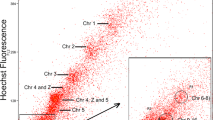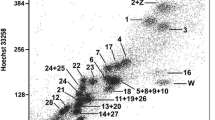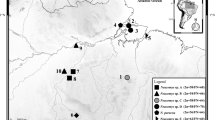Abstract
Recent molecular and morphological studies place Artiodactyla and Cetacea into the order Cetartiodactyla. Within the Cetartiodactyla such families as Bovidae, Cervidae, and Suidae are well studied by comparative chromosome painting, but many taxa that are crucial for understanding cetartiodactyl phylogeny remain poorly studied. Here we present the genome-wide comparative maps of five cetartiodactyl species obtained by chromosome painting with human and dromedary paint probes from four taxa: Cetacea, Hippopotamidae, Giraffidae, and Moschidae. This is the first molecular cytogenetic report on pilot whale, hippopotamus, okapi, and Siberian musk deer. Our results, when integrated with previously published comparative chromosome maps allow us to reconstruct the evolutionary pathway and rates of chromosomal rearrangements in Cetartiodactyla. We hypothesize that the putative cetartiodactyl ancestral karyotype (CAK) contained 25–26 pairs of autosomes, 2n = 52–54, and that the association of human chromosomes 8/9 could be a cytogenetic signature that unites non-camelid cetartiodactyls. There are no unambiguous cytogenetic landmarks that unite Hippopotamidae and Cetacea. If we superimpose chromosome rearrangements on the supertree generated by Price and colleagues, several homoplasy events are needed to explain cetartiodactyl karyotype evolution. Our results apparently favour a model of non-random breakpoints in chromosome evolution. Cetariodactyl karyotype evolution is characterized by alternating periods of low and fast rates in various lineages. The highest rates are found in Suina (Suidae+Tayasuidae) lineage (1.76 rearrangements per million years (R/My)) and the lowest in Cetaceans (0.07 R/My). Our study demonstrates that the combined use of human and camel paints is highly informative for revealing evolutionary karyotypic rearrangements among cetartiodactyl species.







Similar content being viewed by others
Abbreviations
- 2n:
-
diploid number of chromosomes
- BAC:
-
bacterial artificial chromosome
- BTA:
-
Bos taurus
- CAK:
-
cetartiodactyl ancestral karyotype
- CDR:
-
Camelus dromedarius
- DOP-PCR:
-
degenerate oligonucleotide primer–polymerase chain reaction
- FISH:
-
fluorescence in-situ hybridization
- GCA:
-
Giraffa camelopardalis
- GME:
-
Globicephala melas
- GTG:
-
banding G banding by trypsin using Giemsa
- HAM:
-
Hippopotamus amphibius
- HSA:
-
Homo sapiens
- MMO:
-
Moschus moschiferus
- Mya:
-
million years ago
- OJO:
-
Okapia johnstoni
- PAUP:
-
phylogenetic analysis using parsimony
- PTA:
-
Pecari tajacu
- R/My:
-
rearrangements per million years
- SSC:
-
Sus scrofa
References
Adega F, Chaves R, Kofler A et al (2006) High-resolution comparative chromosome painting in the Arizona collared peccary (Pecari tajacu, Tayassuidae): a comparison with the karyotype of pig and sheep. Chromosome Res 14:243–251
Allard MW, Miyamoto MM, Jarecki L, Kraus F, Tennant MR (1992) DNA systematics and evolution of the artiodactyl family Bovidae. Proc Natl Acad Sci USA 89:3972–3976
Arnason U (1972) The role of chromosomal rearrangements in mammalian speciation with special reference to Cetacea and Pinnipedia. Hereditas 70:113–118
Arnason U (1974) Comparative chromosome studies in Cetacea. Heredidas 77:1–36
Arnason U, Gullberg A (1996) Cytochrome b nucleotide sequences and the identification of five primary lineages of extant cetaceans. Mol Biol Evol 13:407–417
Arnason U, Gullberg A, Gretarsdottir S, Ursing B, Janke A (2000) The mitochondrial genome of the sperm whale and a new molecular reference for estimating eutherian divergence dates. J Mol Evol 50:569–578
Avise JC, Robinson TJ (2008) Hemiplasy: a new term in the lexicon of phylogenetics. Sys Biol 57:503–507
Bailey JA, Baertsch R, Kent WJ, Haussler D, Eichler EE (2004) Hotspots of mammalian chromosomal evolution. Genome Biology 5:R 23
Bajpai S, Gingerich PD (1998) A new Eocene archaeocete (Mammalia,Cetacea) from India and the time of origin of whales. Proc Natl Acad Sci USA 95:15464–15468
Balmus G, Trifonov VA, Biltueva LS (2007) Cross species painting among camel, cattle, pig and human: further insights into the putative Cetartiodactyla ancestral karyotype. Chromosome Res 15:499–514
Beck RMD, Bininda-Emonds ORP, Cardillo M, Liu FGR, Purvis A (2006) A higher-level MRP supertree of placental mammals. BMC Evol Biol 6:93
Behrensmeyer AK, Deino AL, Hill A, Kingston JD, Saunders JJ (2002) Geology and geochronology of the middle Miocene Kipsaramon site complex, Muruyur Beds, Tugen Hills, Kenya. J Hum Evol 42:11–38
Bielec PE, Gallagher DS, Womack JE, Busbee DL (1998) Homologies between human and dolphin chromosomes detected by heterologous chromosome painting. Cytogenet Cell Genet 81:18–26
Biltueva LS, Yang F, Vorobieva NV, Graphodatsky AS (2004) Comparative map between the domestic pig and dog. Mamm Genome 15:809–818
Bininda-Emonds ORP, Cardillo M, Jones KE et al (2007) The delayed rise of present-day mammals. Nature 446:507–512
Boisserie JR, Lihoreau F, Brunet M (2005a) The position of hippopotamidae within cetartiodactyla. Proc Natl Acad Sci USA 102(5):1537–1541
Boisserie JR, Lihoreau F, Brunet M (2005b) Origins of Hippopotamidae (Mammalia, Cetartiodactyla): towards resolution. Zool Scr 34(2):119–143
Bonnet-Garnier A, Claro F, Thevenon S, Gantie M, Hayes H (2003) Identification by R-banding and FISH of chromosome arms involved in Robertsonian translocations in several deer species. Chromosome Res 11:649–663
Bosma AA, Haan NA, Arkesteijn GJ, Yang F, Yerle M, Zijlstra C (2004) Comparative chromosome painting between the domestic pig (Sus scrofa) and two species of peccary, the collared peccary (Tayassu tajacu) and the white-lipped peccary (T. pecari): a phylogenetic perspective. Cytogenet Genome Res 105:115–121
Bunch TD, Foote WC, Maciulis A (1985) Chromosome banding pattern homologies and NORs for the Bactrian camel, guanaco and llama. J Hered 76:115–118
Chaves R, Froenicke L, Guedes-Pinto H, Wienberg J (2004) Multidirectional chromosome painting between the Hirola antelope (Damaliscus hunteri, Alcelaphini, Bovidae), sheep and human. Chromosome Res 12:495–503
Chi J, Fu B, Nie W, Wang J, Graphodatsky AS, Yang F (2005a) New insights into the karyotypic relationships of Chinese muntjac (Muntiacus reevesi), forest musk deer (Moschus berezovskii) and gayal (Bos frontalis). Cytogenet Genome Res 108:310–316
Chi JX, Huang L, Nie W, Wang J, Fu B, Yang F (2005b) Defining the orientation of the tandem fusions that occurred during the evolution of Indian muntjac chromosomes by BAC mapping. Chromosoma 114(3):167–172
Ferguson-Smith MA (1997) Genetic analysis by chromosome sorting and painting: phylogenetic and diagnostic applications. Eur J Hum Genet 5:253–265
Fernandez MH, Vrba ES (2005) A complete estimate of the phylogenetic relationships in Ruminantia: a dated species-level supertree of the extant ruminants. Biol Rev 80:269–302
Fitch WM, Beintema JJ (1999) Correcting parsimonious trees for unseen nucleotide substitutions: the effect of dense branching as exemplified by ribonuclease. Mol Biol Evol 7(5):438–443
Fontana F, Rubini M (1990) Chromosome evolution in Cervidae. Biosystems 24:157–174
Froenicke L, Wienberg J (2001) Comparative chromosome painting defines the high rate of karyotype changes between pigs and bovids. Mamm Genome 12:442–449
Froenicke L, Caldés MG, Graphodatsky A et al (2006) Are molecular cytogenetics and bioinformatics suggesting diverging models of ancestral mammalian genomes? Genome Res 16:311–313
Gallagher DS, Derr JN, Womack JE (1994) Chromosome conservation among the advanced pecorans and determination of the primitive bovid karyotype. J Hered 85:204–210
Gatesy J (1997) More DNA support for a Cetacea/Hippopotamidae clade: the blood-clotting protein gene gammafibrinogen. Mol Biology Evol 14:537–543
Graphodatsky AS, Sablina OV, Meyer MN et al (2000) Comparative cytogenetics of hamsters of the genus Calomyscus. Cytogenet Cell Genet 88:296–304
Graphodatsky AS, Yang F, O’Brien PCM et al (2001) Phylogenetic implications of the 38 putative ancestral chromosome segments for four canid species. Cytogenet Cell Genet 92:243–247
Guha S, Goyal SP, Kashyap VK (2007) Molecular phylogeny of musk deer: a genomic view with mitochondrial 16S rRNA and cytochrome b gene. Mol Phylogenet Evol 42(3):585–597
Hasegawa M, Adachi J (1996) Phylogenetic position of cetaceans relative to artiodactyls: reanalysis of mitochondrial and nuclear sequences. Mol Biol Evol 13:710–717
Hassanin A, Douzery EJP (2003) Molecular and morphological phylogenies of Ruminantia and the alternative position of the Moschidae. Syst Biol 52(2):206–228
Huang L, Nie W, Wang J, Su W, Yang F (2005) Phylogenomic study of the subfamily Caprinae by cross-species chromosome painting with Chinese muntjac paints. Chromosome Res 13:389–399
Huang L, Chi J, Nie W, Wang J, Yang F (2006) Phylogenomics of several deer species revealed by comparative chromosome painting with Chinese muntjac paints. Genetica 127:25–33
Huang L, Nesterenko A, Nie W et al (2008) Karyotypic evolution of giraffes (Giraffa camelopardalis) revealed by cross-species chromosome painting with Chinese muntjac (Muntiacus reevesi) and human (Homo sapiens) paints. Cytogenet Genome Res 122:132–138
Hsu TC, Benirschke K (1967) An atlas of mammalian chromosomes. Springer-Verlag, New York
Iannuzzi L, Di Meo GP, Perucatti A, Bardaro T (1998) ZOO-FISH and R-banding reveal extensive conservation of human chromosome regions in euchromatic regions of river buffalo chromosomes. Cytogenet Cell Genet 82:210–214
Janis CM (1993) Tertiary mammal evolution in the context of changing climates, vegetation, and tectonic events. Annu Rev Ecol Syst 24:467–500
Janis CM, Scott KM, Jacobs LL (1998) Evolution of tertiary mammals of north America. terrestrial carnivores, ungulates, and ungulatelike mammals. Cambridge University Press, Cambridge
Kleineidam RG, Pesole G, Breukelman HJ, Beintema JJ, Kastelein RA (1999) Inclusion of £r Artiodactyla based on phylogenetic analysis of pancreatic ribonuclease genes. J Mol Evol 48:360–368
Kuznetsova MV, Kholodova MV, Luschekina AA (2002) Phylogenetic analysis of sequences of the 12S and 16S rRNA mitochondrial genes in the family Bovidae: new evidence. Russ J Genet 38:942–950
Langer P (2001) Evidence from the digestive tract on phylogenetic relationships in ungulates and whales. J Zool Syst Evol Res 39:77–90
Lum JK, Nikaido M, Shimamura M et al (2000) Consistency of SINE insertion topology and flanking sequence tree: quantifying relationships among cetartiodactyls. Mol Biol Evol 17:1417–1424
Mahon A (2004) A molecular supertree of the Artiodactyla. In: Bininda-Emonds ORP (ed) Phylogenetic supertrees: Combining information to reveal the tree of life. Kluwer Academic Publishers, Dordrecht, pp 411–437
Maniou Z, Wallis OC, Wallis M (2003) Episodic molecular evolution of pituitary growth hormone in Cetartiodactyla. J Mol Evol 58:743–753
Marcot JD (2007) Molecular phylogeny of terrestrial artiodactyls. In: Prothero DR, Foss SE (eds) The evolution of artiodactyls. The John Hopkins University Press, Baltimore, pp 4–18
Matthee CA, Burzlaff JD, Taylor JF, Davis SK (2001) Mining the mammalian genome for artiodactyl systematics. Syst Biol 50:367–390
Matthee CA, Eick G, Willows-Munro S, Montgelard C, Pardini AT, Robinson TJ (2007) Indel evolution of mammalian introns and the utility of non-coding nuclear markers in eutherian phylogenetics. Mol Phylogenet Evol 42:827–837
Montgelard C, Catzejfis MF, Douzery E (1997) Phylogenetic relationships of artiodactyls and cetaceans as deduced from the comparison of cytochrome b and 12s rRNA mitochondrial sequences. Mol Biol Evol 14(5):550–559
Murphy WJ, Eizirik E, Johnson WE, Zhang YP, Ryder OA, O’Brien SJ (2001) Molecular phylogenetics and the origins of placental mammals. Nature 409:614–618
Murphy WJ, Pringle TH, Tess A, Crider TA, Springer MS, Miller W (2007) Using genomic data to unravel the root of the placental mammal phylogeny. Genome Res 17:413–421
Nikaido M, Rooney AP, Okada N (1999) Phylogenetic relationships among cetartiodactyls based on insertions of short and long interpersed elements: Hippopotamuses are the closest extant relatives of whales. Proc Natl Acad Sci USA 96:10261–10266
Nishihara H, Hasegawa M, Okada N (2006) Pegasoferae, an unexpected mammalian clade revealed by tracking ancient retroposon insertions. Proc Natl Acad Sci USA 103:9929–9934
Nowak RM (1999) Order artiodactyla. In: Walker’s mammals of the world. John Hopkins University Press, London
O’Leary MA, Geisler JH (1999) The position of Cetecea within Mammalia: Phylogenetic analysis of morphological data from extinct and extant taxa. Syst Biol 48:455–490
Pevzner P, Tesler G (2003) Human and mouse genomic sequences reveal extensive breakpoint reuse in mammalian evolution. Proc Natl Acad Sci USA 100:7672–7677
Pinton P, Schibler L, Cribiu E, Gellin J, Yerle M (2000) Localization of 113 anchor loci in pigs: improvement of the comparative map for humans, pigs, and goats. Mamm Genome 11:306–315
Price SA, Bininda-Emonds ORP, Gittleman JL (2005) A complete phylogeny of the whales, dolphins and even-toed hoofed mammals (Cetartiodactyla). Biol Rev 80:445–473
Robinson TJ, Ruiz-Herrera A, Avise JC (2008) Hemiplasy and homoplasy in the karyotypic phylogenies of mammals. Proc Natl Acad Sci USA 105:14477–14481
Rose KD (1996) On the origin of the order Artiodactyla. Proc Natl Acad Sci USA 93:1705–1709
Ryder OA (2006a) A G-stained karyotype of Massai giraffe (Giraffa camelopardalis tippelskirchi). In: O’Brien SJ, Menninger JC, Nash WG (eds) Atlas of mammalian chromosomes. Wiley-Liss, Hoboken, NJ, p 577
Ryder OA (2006b) A G- stained karyotype of okapi (Okapia johnstoni). In: O’Brien SJ, Menninger JC, Nash WG (eds) Atlas of mammalian chromosomes, Wiley-Liss, Hoboken, NJ, p 577
Seabright M (1971) A rapid banding technique for human chromosomes. Lancet 2:971–972
Shimamura M, Yasue H, Ohshima K, Abe H, Kato H, Kishiro T, Goto M, Munechikak I, Okada N (1997) Molecular evidence from retroposons that whales form a clade within even toed ungulates. Nature 388:666–670
Simpson CD (1984) Artiodactyls. In: Anderson S, Jones JK (eds) Orders and Families of Recent Mammals of the World. Wiley, New York, pp 563–588
Slate J, Stijn TCV, Anderson RM et al (2002) A deer (Subfamily Cervinae) genetic linkage map and the evolution of ruminant genomes. Genetics 160:1587–1597
Stanley HF, Kadwell M, Wheeler JC (1994) Molecular evolution of the family Camelidae: a mitochondrial study. Proc R Soc Lond B 256:1–6
Stanyon R (2006) A G- stained karyotype of hippopotamus (Hippopotamus amphibius). In: O’Brien SJ, Menninger JC, Nash WG (eds) Atlas of Mammalian Chromosomes. Wiley-Liss, Hoboken, NJ, p 573
Su B, Wang YX, Lan H, Wang W, Zhang Y (1999) Phylogenetic study of complete cytochrome b genes in musk deer (genus Moschus) using museum samples. Mol Phylogenet Evol 12:241–249
Telenius H, Carter NP, Bebb CE, Nordenskjold M, Ponder BA, Tunnacliffe A (1992) Degenerate oligonucleotide-primed PCR: general amplification of target DNA by a single degenerate primer. Genomics 13:718–725
Theodor JM (2004) Molecular clock divergence estimates and the fossil record of Cetartiodactyla. J Paleontol 78:39–44
Trifonov VA, Stanyon R, Nesterenko AI et al (2008) Multidirectional cross-species painting illuminates the history of karyotypic evolution in Perissodactyla. Chromosome Res 16:89–107
Ursing BM, Arnason U (1998) Analyses of mitochondrial genomes strongly support a hippopotamus–whale clade. Proc R Soc Lond B 265:2251–2255
Volleth M, Heller KG, Pfeiffer RA, Hameister H (2002) A comparative ZOO-FISH analysis in bats elucidates the phylogenetic relationships between Megachiroptera and five microchiropteran families. Chromosome Res 10:477–497
Wurster DH, Benirschke K (1968) Chromosome studies in the superfamily Bovoidea. Chromosoma 25:152–171
Yang F, O’Brien PC, Wienberg J, Ferguson-Smith MA (1997a) A reappraisal of the tandem fusion theory of karyotype evolution in the Indian muntjac using chromosome painting. Chromosome Res 5:109–117
Yang F, O’Brien PC, Wienberg J, Neitzel H, Lin CC, Ferguson-Smith MA (1997b) Chromosomal evolution of the Chinese muntjac (Muntiacus reevesi). Chromosoma 106:37–43
Yang F, O’Brien PC, Wienberg J, Ferguson-Smith MA (1997c) Evolution of the black muntjac (Muntiacus crinifrons) karyotype revealed by comparative chromosome painting. Cytogenet Cell Genet 76:159–163
Yang F, O’Brien PC, Milne BS et al (1999) A complete comparative chromosome map for the dog, red fox, and human and its integration with canine genetic maps. Genomics 62:189–202
Yang F, Fu B, O’Brien PC, Robinson TJ, Ryder OA, Ferguson-Smith MA (2003) Karyotypic relationships of horses and zebras: results of cross-species chromosome painting. Cytogenet Genome Res 102:235–343
Yang F, Fu B, O’Brien PC, Nie W, Ryder OA, Ferguson-Smith MA (2004) Refined genome-wide comparative map of the domestic horse, donkey and human based on cross-species chromosome painting: insight into the occasional fertility of mules. Chromosome Res 12:65–76
Acknowledgements
This study was funded in part by the research grants of the Russian Fund for Basic Research, programs of the Russian Academy of Science MCB, BOE, and Integration program of the Siberian Branch of the Russian Academy of Science (A.S.G.) and a Wellcome Trust grant to M.A.F.-S.
R.S. was partially supported by a grant ‘Mobility of Italian and foreign researchers residing abroad’ from the Italian Ministry of Universities and Research. F.Y. is supported by the Wellcome Trust. We gratefully acknowledge Stephen O’Brien (Laboratory of Genomic Diversity, NCI-Frederick) for providing cell lines of whale and okapi; Marlys Houck and Oliver A. Ryder (Frozen Zoo of San Diego Zoo’s Conservation Research Center, CA) for providing hippo and giraffe cell lines; and Michael Dean, M. Thompson (NCI-Frederick) for help in providing giraffe samples.
R.S. would like to acknowledge Lutz Froenike for discussion and comments on whale phylogenetics.
Author information
Authors and Affiliations
Corresponding author
Additional information
Responsible Editor: Herbert Macgregor.
Electronic supplementary material
Below is the image is a link to a high resolution version
Supplementary Fig. S1
FISH examples of localization of some human (HSA) and dromedary (CDR) probes onto studied species (JPG 1.29 MB)
Supplementary Fig. S2
FISH of dromedary (CDR) painting probes onto cow (BTA) and pig (SSC), with additional signals revealed (JPG 571 kb)
Supplementary Fig. S3
Supplementary figure S3 Schemes of possible chromosome rearrangements for two conserved associations: CDR 23/21/9/13 and CDR 4/31 (JPG 1.21 MB)
Rights and permissions
About this article
Cite this article
Kulemzina, A.I., Trifonov, V.A., Perelman, P.L. et al. Cross-species chromosome painting in Cetartiodactyla: Reconstructing the karyotype evolution in key phylogenetic lineages. Chromosome Res 17, 419–436 (2009). https://doi.org/10.1007/s10577-009-9032-3
Received:
Revised:
Accepted:
Published:
Issue Date:
DOI: https://doi.org/10.1007/s10577-009-9032-3




